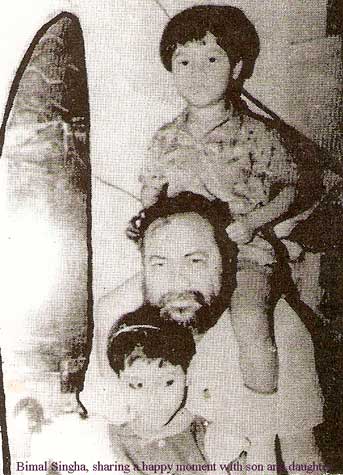Besides working for the poor, Bimal Singha had been nurturing literary ambitions. His writings began creating ripples in the literary circles. Perhaps the wounded feeling at not being offered a ministerial berth motivated him to take up writing more seriously. His works bear testimony to his devotion to the cause of the poor and the oppressed. He created Tripura’s first feature film “Longtorai’, based on his novel bearing the same name. The film is the first documentation of the misery, suffering and exploitation of the hill tribes in Tripura. One thing must be noted hear: Bimal Singha thought, worked and wrote most for the tribesmen because they were the most oppressed. But this does not necessarily mean that he had a bias in favour of the hill tribes. A thorough study of his works and deeds will make it clear that his heart bled for the marginalized, be they Bengalis or tribespeople.
His literary works ‘Basaner Thakuma’, ‘Titas theke Tripura’ and the like testify to his feelings for the displaced Bengalis who sought shelter in hilly Tripura and toiled hard to scrape a living. Bimal Singha was a born rebel. He never turned a blind eye to an instance of injustice or exploitation. This explains why he plunged into the freedom struggle that led to the creation of Bangladesh. It was he who was most instrumental in ensuring safety of the Bishnupriya Manipuris of present-day Bangladesh when war broke out in 1971. He took great risks like sneaking into the battle-torn region to evacuate the B. Manipuris of Bhanubil, Shreepur and other Manipuri localities. However, it would amount to underrating his contribution to say he had concern only for the Bishnupriya Manipuris. He was a whole-timer at the time of war overseeing the arrangements for the refugees of all sections from across the border, and extending all sorts of practical help to the Mukti Bahini. He worked in close association with Padmasen Singha of the then East Pakistan, another great son of the Bishnupriya Manipuris whose contribution to the freedom movement of Bangladesh is widely acclaimed by all sections of people. No wonder, the Bangladesh border was open on the day on which Bimal Singha’s Sraddha ceremony held. Not only Manipuris, even Bengali Muslims from across the border came to pay their respect to the people’s leader.
Bimal Singha’s most important contribution to humanity however is his work for the poor and destitute. The great lover of mankind clamoured most for the most vulnerable i.e. the tribespeople of Tripura. He learned their languages, picked up their food habits and acclimatized himself to a life of simplicity and hardship. This assimilation of tribal culture gave the world a priceless asset – his literary creations. Many are waiting to see the mystery surrounding his death unveiled. Some are interested in exploring his revolutionary exploits. But very few really evaluate his literary genius. Bimal Singha’s portrayal of life in Tripura hills form a unique genre of literature. Few could have realized before him that there could be so much love, so much passion, so much pathos and so many stories in the apparently uninspiring, naked, rugged life of various tribes who faced the treat of biological extinction. His literary pursuit seems to have drawn inspiration from writers like Mikhail Sholokhov, Bibhuti Bhushan Bondopadhyay, Charles Dickens and Mahashweta Devi. Sholokhov’s portrayal of the settings and events (which the reader sees while he reads and forgets he was reading and not seeing things before his eyes), Dickens’s and Bibhuti Bhushan’s sensitivity, Mahashweta Devi’s concern for the have-nots and rebelliousness, all seemed to coalesce into what we may call Bimal’s genre.

Next on this space, Bimal Singha’s creative exploits. Keep clicking!